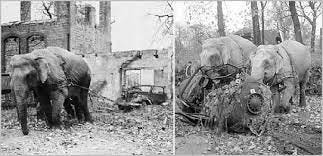War is deadly for all earthlings…
Do you think non-humans are ever spared during military conflicts?
“I think the discomfort that some people feel in going to the monkey cages at the zoo is a warning sign.” (Carl Sagan)
The March 6, 2022 headline jumped out at me: “Kyiv Zoo staff and families care for nearly 4,000 animals amid war in Ukraine.” Once again, I began to ponder the non-human collateral damage of uniquely human decisions.
On February 13-14, 1945, Allied bombers laid siege to the German city of Dresden. Within the target zone was the Dresden Zoo, run by animal trainer Otto Sailer-Jackson. The standing Nazi order was that if human life was endangered, all carnivores must be shot.
Sailer-Jackson recalled the scene: “The elephants gave spine-chilling screams. Their house was still standing but an explosive bomb of terrific force had landed behind it, lifted the dome of the house, turned it around, and put it back on again… The baby cow elephant was lying in the narrow moat on her back, her legs up to the sky. She had suffered severe stomach injuries and could not move.”
Three hippopotamuses were drowned when iron debris pinned them to the bottom of their water basin. In the ape house, Sailer-Jackson found a gibbon that, when it reached out to the trainer, had no hands, only stumps. Nearly forty rhesus monkeys escaped to the trees but were dead by the next day from drinking water polluted by the incendiary chemicals.
For those animals that made it to the next day, the assault was far from over. A U.S. aircraft pilot came in low, firing at anything he could see was still alive. “In this way,” Sailer-Jackson explained, “our last giraffe met her death. Many stags and other animals which we had managed to save became victims of this hero.”
Modern-day wars are no less lethal to non-human earthlings. Shortly after the U.S. invasion and occupation of Iraq commenced in 2003, the Bahrain Gulf Daily News reported that looters had emptied Baghdad Zoo of its animals “Monkeys, bears, horses, birds, and camels have disappeared, carted off by thieves or simply left to roam the streets after their cages were pried open,” the paper reported. More than 300 animals went missing — only the lions and tigers remained. And the big cats were starving.
Some five months later, parts of the zoo were back up and running and U.S. soldiers were partying with Iraqi police after hours there.
Here’s what happened next: “A group of U.S. soldiers in civvies arrived at the zoo to party, armed with guns and beer. Mendouh the tiger was shot in the head three times after injuring a soldier who was trying to feed it through the bars of its cage. Headkeeper Adil Salman Musa said: ‘The tiger bit his finger off and clawed his arm. So his colleague took a gun and shot the tiger.’”
Some animals from the Kyiv Zoo were rescued and smuggled to Poland but, even so, let’s make it clear that — war or no war — zoos suck, e.g.
Animals are obviously not meant to live in captivity and, as a result, often display stress and/or psychological dysfunction. Just as often, these animals are abused.
Zoos serve to reduce genetic diversity and do not contribute to increasing robust animal populations in the wild.
Zoos are mostly focused on "cute babies" and ultimately create unwanted animals.
Captive breeding can create a false sense that the battle to save endangered species and habitats is being won.
Zoos do little to nothing to seriously address the underlying causes of habitat loss and thereby let the perpetrators off the hook.
Warehousing endangered species sends the frightening subliminal message that it's acceptable to spend money to view animals in enclosures while, for example, forests are being clear-cut to make way for doomed livestock — depriving many of those same animals the freedom to live in their own habitats.
This line of thinking brings to mind a time in 2013 when the Central Park Zoo euthanized a 27-year-old polar bear named "Gus" and the New York Times had a field day mocking poor Gus as “neurotic.”
How depraved of a species have we become? An apex predator, designed to live in the frozen north, is born into captivity in Toledo and then shipped to the most populated urban area in the nation — but we give him a human name and label him neurotic when he doesn't behave “normally.” Then, when we decide the time is right, we euphemistically put the prisoner to sleep.
Pro tip: These captive animals aren't asleep, we are — and while we sleep, we regularly conjure up nightmares to rain down upon all life on Earth. We, my fellow humans, are the ones who must wake the fuck up.
Whether we call it a cage, a cell, a jail, a pen, a prison, a wildlife center, an enclosure, a zoo, an aquarium, or a “show,” incarceration is incarceration. Encountering animals in such a setting teaches us the wrong lessons about how the ecosystem works — lessons that work to sustain a destructive culture that should be dismantled immediately.
Make no mistake, any society that confines and abuses animals for profit is just as likely to regularly promote and engage in other forms of violence and exploitation against all forms of life.
As you consume your daily doses of propaganda, take a few minutes to ponder the bigger pictures and underlying assumptions behind all varieties of fake news. And then contemplate how many innocent beings — humans, non-humans, and more — will suffer and die until we finally become lucid and create change.
Shift happens…








